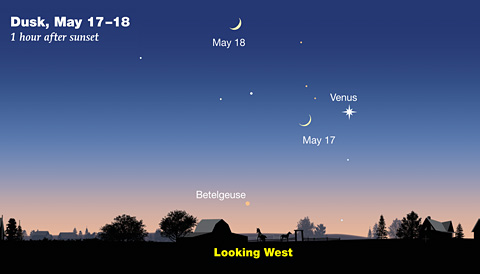This month's astronomy podcast tells you how to use Venus and the Big Dipper to find many bright stars and constellations. Meanwhile, Jupiter lurks low in the east after darkness falls.
During most of this month, the Sun doesn’t set until nearly 8 o’clock, so it’s not really dark until well after dinnertime. And you might even need lightweight long-sleeved clothing or some bug spray to ward off the season’s first wave of insects.

Sky & Telescope
But there's always plenty to see in the night sky after the Sun goes down, and May is no exception.
Look for hard-to-miss Venus low in the west as darkness falls.You can use Venus to identify several bright stars in its part of the sky. This month's astronomy podcast tells you how to do that — and you'll learn their names too!
The Big Dipper is another easy-to-find benchmark in the evening skies of May. Look for it almost directly overhead at nightfall. The dipper is an easy-to-spot pattern of stars that's part of the constellation Ursa Major, the Big Bear. You can use the Dipper to find the stars Arcturus, Spica, Regulus, and even Polaris (the North Star).
A little later in the evening, Jupiter makes its entrance on opposite side of the sky. Like Venus, it's bright and easy to spot. Jupiter reaches opposition on May 8th, so it rises at sunset, gets highest in the sky soon after midnight, and sets near the time of sunrise. This month Jupiter will appear its brightest for the whole year.
For all the celestial highlights in the week's ahead, play or download this month's 7-minute-long astronomy podcast (linked below).
Podcast: Play in new window | Download
Subscribe: Apple Podcasts | Google Podcasts | Spotify | Email | RSS | More
 1
1
Comments
Ike
May 4, 2018 at 6:04 pm
" gets highest in the sky soon after midnight", referring to Jupiter at opposition. Shouldn't that be "about 1 a.m.", since we are in Daylight Savings Time?
You must be logged in to post a comment.
You must be logged in to post a comment.